On Green Hydrogen Generation Technologies: A Bibliometric Review
Abstract
1. Introduction
- It is an important energy carrier, and when used as a fuel, it can be considered an alternative to the main fossil fuels, such as coal, crude oil, and natural gas, and their derivatives.
- It is a clean, reliable, and affordable source of energy and has the great advantage that the product of its combustion with oxygen is water, instead of CO and CO2.
- It can be used directly in internal combustion reciprocating internal combustion engines, requiring relatively minor modifications if boosted to a moderately high pressure, as well as in turbines and boilers.
- It can be used in hydrogen/oxygen fuel cells to directly produce electricity. Again, the only product is H2O.
- It can also be used in fuel cells with higher temperatures to generate electricity and heat simultaneously (as a cogeneration plant).
- Pink hydrogen is also known as synthetic hydrogen, and it is produced by electrolysis of water using nuclear energy. Although it is considered clean, its large-scale production presents regulatory and safety challenges [18];
- Yellow hydrogen is produced from the electrolysis of water using concentrated solar power (CSP) [19];
- Black hydrogen is generated from the combustion of coal; therefore, it is extremely polluting [20];
- Brown hydrogen is similar to black in terms of CO2 emissions, and it is based on the combustion of lignite to generate hydrogen [21];
- Orange hydrogen is produced from emissions or waste from other sectors [22];
- White hydrogen is the one stored in subway reservoirs [23].
- Proton exchange membrane (PEM) electrolyzers: these electrolyzers are very popular, and many modern electrolyzers are built with this technology. The electrolyte is a thin ion-conducting solid membrane used in place of the aqueous solution [31];
- Solid oxide electrolytic cells (SOECs): these are basically a corresponding fuel cell operating in reverse [32].
2. Materials and Methods
3. Results
4. Discussion
| Challenge | Description | Added Search Field | Number Results (%) | References |
|---|---|---|---|---|
| Limited infrastructure | In the various key stages of green hydrogen—production, storage, and distribution—high financial investments are needed to develop an infrastructure that is currently in an early stage of development. | AND (“infrastru*” OR “develop*” OR “facilities” OR “instala*”) | 189 (62.5%) | [50,57] |
| Low electrolysis efficiency | Although it has improved, electrolysis faces major challenges in terms of energy efficiency. Improving the effectiveness of electrolyzers is critical to making green hydrogen production more sustainable. | AND (“efficien*” OR “abili*” OR “capabili*” OR “producti*”) | 285 (94.3%) | [58,59,60,61,62,63] |
| High technical complexity in storage and transport | Hydrogen is a difficult gas to store and transport efficiently. Advances in advanced storage technologies and safe and efficient transportation systems are needed. | AND (“storage*” OR “distribu*” OR “transpor*”) | 156 (51.6%) | [64,65] |
| Economic viability | Although production costs have decreased, they are still relatively high compared to other technologies. Green hydrogen must be positioned from the point of view of economic profitability compared to other technologies such as gray hydrogen. | AND (“econo*” OR “viabi*” OR “valid*” OR “habili*”) | 125 (41.4%) | [58,62] |
| Environmental impact | The development of this technology implies a certain environmental impact, as well as the consumption of sometimes scarce material resources. | AND (“enviro*” OR “ecolo*” OR “impact” OR “natural”) | 149 (49.3%) | [66] |
5. Conclusions
Author Contributions
Funding
Conflicts of Interest
Nomenclature
| Acronyms and Nomenclatures | Description |
| ALK | Alkaline electrolyzer |
| CSP | Concentrated solar power |
| GHG | Greenhouse gas emissions |
| IEA | International Energy Agency |
| PEM | Proton exchange membrane electrolyzer |
| RoW | Rest of the world |
| SOEC | Solid oxide electrolytic cell |
References
- Sadik-Zada, E.R. Political Economy of Green Hydrogen Rollout: A Global Perspective. Sustainability 2021, 13, 13464. [Google Scholar] [CrossRef]
- Wang, Q.; Kong, X.Y.; Wang, Y.; Wang, L.; Huang, Y.; Li, H.; Ma, T.; Ye, L. Metal-Free Photocatalysts for Conversion of H2O into Hydrogen Peroxide. ChemSusChem 2022, 15, e202201514. [Google Scholar] [CrossRef]
- Ohi, J. Hydrogen energy cycle: An overview. J. Mater. Res. 2005, 20, 3180–3187. [Google Scholar] [CrossRef]
- Dawood, F.; Anda, M.; Shafiullah, G.M. Hydrogen production for energy: An overview. Int. J. Hydrog. Energy 2020, 45, 3847–3869. [Google Scholar] [CrossRef]
- Bailera, M.; Kezibri, N.; Romeo, L.M.; Espatolero, S.; Lisbona, P.; Bouallou, C. Future applications of hydrogen production and CO2 utilization for energy storage: Hybrid Power to Gas-Oxycombustion power plants. Int. J. Hydrog. Energy 2017, 42, 13625–13632. [Google Scholar] [CrossRef]
- Zhang, W.; Fang, X.; Sun, C. The alternative path for fossil oil: Electric vehicles or hydrogen fuel cell vehicles? J. Environ. Manag. 2023, 341, 118019. [Google Scholar] [CrossRef]
- Dufour, J.; Serrano, D.P.; Gálvez, J.L.; González, A.; Soria, E.; Fierro, J.L.G. Life cycle assessment of alternatives for hydrogen production from renewable and fossil sources. Int. J. Hydrog. Energy 2012, 37, 1173–1183. [Google Scholar] [CrossRef]
- Saxe, M.; Alvfors, P. Advantages of integration with industry for electrolytic hydrogen production. Energy 2007, 32, 42–50. [Google Scholar] [CrossRef]
- Savateev, A.; Antonietti, M. Ionic Carbon Nitrides in Solar Hydrogen Production and Organic Synthesis: Exciting Chemistry and Economic Advantages. ChemCatChem 2019, 11, 6166. [Google Scholar] [CrossRef]
- Pachapur, V.L.; Kutty, P.; Pachapur, P.; Brar, S.K.; Le Bihan, Y.; Galvez-Cloutier, R.; Buelna, G. Seed Pretreatment for Increased Hydrogen Production Using Mixed-Culture Systems with Advantages over Pure-Culture Systems. Energies 2019, 12, 530. [Google Scholar] [CrossRef]
- Noussan, M.; Raimondi, P.P.; Scita, R.; Hafner, M. The Role of Green and Blue Hydrogen in the Energy Transition—A Technological and Geopolitical Perspective. Sustainability 2021, 13, 298. [Google Scholar] [CrossRef]
- Oliveira, A.M.; Beswick, R.R.; Yan, Y. A green hydrogen economy for a renewable energy society. Curr. Opin. Chem. Eng. 2021, 33, 100701. [Google Scholar] [CrossRef]
- Atilhan, S.; Park, S.; El-Halwagi, M.M.; Atilhan, M.; Moore, M.; Nielsen, R.B. Green hydrogen as an alternative fuel for the shipping industry. Curr. Opin. Chem. Eng. 2021, 31, 100668. [Google Scholar] [CrossRef]
- Hermesmann, M.; Müller, T.E. Green, Turquoise, Blue, or Grey? Environmentally friendly Hydrogen Production in Transforming Energy Systems. Prog. Energy Combust. Sci. 2022, 90, 100996. [Google Scholar] [CrossRef]
- Van Renssen, S. The hydrogen solution? Nat. Clim. Chang. 2020, 10, 799–801. [Google Scholar] [CrossRef]
- Howarth, R.W.; Jacobson, M.Z. How green is blue hydrogen? Energy Sci. Eng. 2021, 9, 1676–1687. [Google Scholar] [CrossRef]
- Durakovic, G.; Crespo, P.; Tomasgard, A. Are green and blue hydrogen competitive or complementary? Insights from a decarbonized European power system analysis. Energy 2023, 282, 128282. [Google Scholar] [CrossRef]
- Shirizadeh, B.; Quirion, P. Long-term optimization of the hydrogen-electricity nexus in France: Green, blue, or pink hydrogen? Energy Policy 2023, 181, 113702. [Google Scholar] [CrossRef]
- Shaner, M.R.; Atwater, H.A.; Lewis, N.S.; McFarland, E.W. A comparative technoeconomic analysis of renewable hydrogen production using solar energy. Energy Environ. Sci. 2016, 9, 2354–2371. [Google Scholar] [CrossRef]
- Incer-Valverde, J.; Korayem, A.; Tsatsaronis, G.; Morosuk, T. “Colors” of hydrogen: Definitions and carbon intensity. Energy Convers. Manag. 2023, 291, 117294. [Google Scholar] [CrossRef]
- Yu, J.; Tian, F.J.; Chow, M.C.; McKenzie, L.J.; Li, C.-Z. Effect of iron on the gasification of Victorian brown coal with steam: Enhancement of hydrogen production. Fuel 2006, 85, 127–133. [Google Scholar] [CrossRef]
- Osselin, F.; Soulaine, C.; Fauguerolles, C.; Gaucher, E.C.; Scaillet, B.; Pichavant, M. Orange hydrogen is the new green. Nat. Geosci. 2022, 15, 765–769. [Google Scholar] [CrossRef]
- Unveiling the Potential of White Hydrogen: A Game-Changer in Clean Energy? Available online: https://energyadvicehub.org/what-is-white-hydrogen/ (accessed on 31 December 2023).
- Jovan, D.J.; Dolanc, G. Can Green Hydrogen Production Be Economically Viable under Current Market Conditions. Energies 2020, 13, 6599. [Google Scholar] [CrossRef]
- Díaz-Abad, S.; Millán, M.; Rodrigo, M.A.; Lobato, J. Review of Anodic Catalysts for SO2 Depolarized Electrolysis for “Green Hydrogen” Production. Catalysts 2019, 9, 63. [Google Scholar] [CrossRef]
- Kumar, S.S.; Lim, H. An overview of water electrolysis technologies for green hydrogen production. Energy Rep. 2022, 8, 13793–13813. [Google Scholar] [CrossRef]
- Ayodele, T.R.; Munda, J.L. Potential and economic viability of green hydrogen production by water electrolysis using wind energy resources in South Africa. Int. J. Hydrog. Energy 2019, 44, 17669–17687. [Google Scholar] [CrossRef]
- Bilgen, E. Solar hydrogen from photovoltaic-electrolyzer systems. Energy Convers. Manag. 2001, 42, 1047–1057. [Google Scholar] [CrossRef]
- Liu, Z.; Sajjad, S.D.; Gao, Y.; Yang, H.; Kaczur, J.J.; Masel, R.I. The effect of membrane on an alkaline water electrolyzer. Int. J. Hydrog. Energy 2017, 42, 29661–29665. [Google Scholar] [CrossRef]
- Bodner, M.; Hofer, A.; Hacker, V. H2 generation from alkaline electrolyzer. Energy Environ. 2015, 4, 365–381. [Google Scholar] [CrossRef]
- Falcão, D.S.; Pinto, A.M.F.R. A review on PEM electrolyzer modelling: Guidelines for beginners. J. Clean. Prod. 2020, 261, 121184. [Google Scholar] [CrossRef]
- Ni, M.; Leung, M.K.H.; Leung, D.Y.C. Technological development of hydrogen production by solid oxide electrolyzer cell (SOEC). Int. J. Hydrog. Energy 2008, 33, 2337–2354. [Google Scholar] [CrossRef]
- Herrera-Franco, G.; Montalván-Burbano, N.; Carrión-Mero, P.; Apolo-Masache, B.; Jaya-Montalvo, M. Research Trends in Geotourism: A Bibliometric Analysis Using the Scopus Database. Geosciences 2020, 10, 379. [Google Scholar] [CrossRef]
- Sánchez, A.D.; Del Río, M.D.L.C.; García, J.Á. Bibliometric analysis of publications on wine tourism in the databases Scopus and WoS. Eur. Res. Manag. Bus. Econ. 2017, 23, 8–15. [Google Scholar] [CrossRef]
- Huang, Y.-J.; Cheng, S.; Yang, F.-Q.; Chen, C. Analysis and Visualization of Research on Resilient Cities and Communities Based on VOSviewer. Int. J. Environ. Res. Public Health 2022, 19, 7068. [Google Scholar] [CrossRef]
- Meng, L.; Wen, K.-H.; Brewin, R.; Wu, Q. Knowledge Atlas on the Relationship between Urban Street Space and Residents’ Health—A Bibliometric Analysis Based on VOSviewer and CiteSpace. Sustainability 2020, 12, 2384. [Google Scholar] [CrossRef]
- Coiante, D.; Barra, L. Can photovoltaics become an effective energy option? Sol. Energy Mater. Sol. Cells 1992, 27, 79–89. [Google Scholar] [CrossRef]
- The Future of the Hydrogen Will Be Green. Available online: https://aleasoft.com/future-hydrogen-will-be-green/ (accessed on 1 February 2024).
- International Energy Agency. Global Hydrogen Review 2022. Available online: https://www.iea.org/reports/global-hydrogen-review-2022 (accessed on 23 January 2023).
- Twidell, J. Renewable Energy Resources; Routledge: London, UK, 2021. [Google Scholar]
- Ellabban, O.; Abu-Rub, H.; Blaabjerg, F. Renewable energy resources: Current status, future prospects and their enabling technology. Renew. Sustain. Energy Rev. 2014, 39, 748–764. [Google Scholar] [CrossRef]
- Kumar, M. Social, economic, and environmental impacts of renewable energy resources. In Wind Solar Hybrid Renewable Energy System; Books on Demand: Norderstedt, Germany, 2020; Volume 1. [Google Scholar]
- Sorrell, S. Reducing energy demand: A review of issues, challenges and approaches. Renew. Sustain. Energy Rev. 2015, 47, 74–82. [Google Scholar] [CrossRef]
- Nematollahi, O.; Hoghooghi, H.; Rasti, M.; Sedaghat, A. Energy demands and renewable energy resources in the Middle East. Renew. Sustain. Energy Rev. 2016, 54, 1172–1181. [Google Scholar] [CrossRef]
- Shove, E.; Walker, G. What Is Energy For? Social Practice and Energy Demand. Theory Cult. Soc. 2014, 31, 41–58. [Google Scholar] [CrossRef]
- Squadrito, G.; Maggio, G.; Nicita, A. The green hydrogen revolution. Renew. Energy 2023, 216, 119041. [Google Scholar] [CrossRef]
- Panchenko, V.A.; Daus, Y.V.; Kovalev, A.A.; Yudaev, I.V.; Litti, Y.V. Prospects for the production of green hydrogen: Review of countries with high potential. Int. J. Hydrog. Energy 2023, 48, 4551–4571. [Google Scholar] [CrossRef]
- Mneimneh, F.; Ghazzawi, H.; Abu Hejjeh, M.; Manganelli, M.; Ramakrishna, S. Roadmap to Achieving Sustainable Development via Green Hydrogen. Energies 2023, 16, 1368. [Google Scholar] [CrossRef]
- Hassan, Q.; Algburi, S.; Sameen, A.Z.; Salman, H.M.; Jaszczur, M. Green hydrogen: A pathway to a sustainable energy future. Int. J. Hydrog. Energy 2024, 50, 310–333. [Google Scholar] [CrossRef]
- Zainal, B.S.; Ker, P.J.; Mohamed, H.; Ong, H.C.; Fattah, I.M.R.; Rahman, S.M.A.; Nghiem, L.D.; Mahlia, T.M.I. Recent advancement and assessment of green hydrogen production technologies. Renew. Sustain. Energy Rev. 2024, 189, 113941. [Google Scholar] [CrossRef]
- Asif, M.; Sidra Bibi, S.; Ahmed, S.; Irshad, M.; Shakir Hussain, M.; Zeb, H.; Kashif Khan, M.; Kim, J. Recent advances in green hydrogen production, storage and commercial-scale use via catalytic ammonia cracking. Chem. Eng. J. 2023, 473, 145381. [Google Scholar] [CrossRef]
- Calise, F. Recent Advances in Green Hydrogen Technology. Energies 2022, 15, 5828. [Google Scholar] [CrossRef]
- Ma, N.; Zhao, W.; Wang, W.; Li, X.; Zhou, H. Large scale of green hydrogen storage: Opportunities and challenges. Int. J. Hydrog. Energy 2024, 50, 379–396. [Google Scholar] [CrossRef]
- Vallejos-Romero, A.; Cordoves-Sánchez, M.; Cisternas, C.; Sáez-Ardura, F.; Rodríguez, I.; Aledo, A.; Boso, Á.; Prades, J.; Álvarez, B. Green Hydrogen and Social Sciences: Issues, Problems, and Future Challenges. Sustainability 2022, 15, 303. [Google Scholar] [CrossRef]
- Risco-Bravo, A.; Varela, C.; Bartels, J.; Zondervan, E. From green hydrogen to electricity: A review on recent advances, challenges, and opportunities on power-to-hydrogen-to-power systems. Renew. Sustain. Energy Rev. 2024, 189, 113930. [Google Scholar] [CrossRef]
- Aravindan, M.; Kumar, P. Hydrogen towards sustainable transition: A review of production, economic, environmental impact and scaling factors. Results Eng. 2023, 20, 101456. [Google Scholar] [CrossRef]
- Meda, U.S.; Rajyaguru, Y.V.; Pandey, A. Generation of green hydrogen using self-sustained regenerative fuel cells: Opportunities and challenges. Int. J. Hydrog. Energy 2023, 48, 28289–28314. [Google Scholar] [CrossRef]
- Schmidt, O.; Gambhir, A.; Staffell, I.; Hawkes, A.; Nelson, J.; Few, S. Future cost and performance of water electrolysis: An expert elicitation study. Int. J. Hydrog. Energy 2017, 42, 30470–30492. [Google Scholar] [CrossRef]
- Harrison, K.; Levene, J.I. Electrolysis of Water. In Solar Hydrogen Generation; Rajeshwar, K., McConnell, R., Licht, S., Eds.; Springer: New York, NY, USA, 2008; p. 44. [Google Scholar] [CrossRef]
- Duan, Z.; Mei, N.; Feng, L.; Yu, S.; Jiang, Z.; Chen, D.; Xu, X.; Hong, J. Research on Hydrogen Consumption and Driving Range of Hydrogen Fuel Cell Vehicle under the CLTC-P Condition. World Electr. Veh. J. 2022, 13, 9. [Google Scholar] [CrossRef]
- Cheng, H.; Xia, Y.; Wei, W.; Zhou, Y.; Zhao, B.; Zhang, L. Safety and efficiency problems of hydrogen production from alkaline water electrolyzers driven by renewable energy sources. Int. J. Hydrog. Energy 2023, 54, 700–712. [Google Scholar] [CrossRef]
- Hassan, N.S.; Jalil, A.A.; Rajendran, S.; Khusnun, N.F.; Bahari, M.B.; Johari, A.; Kamaruddin, M.M.; Ismail, M. Recent review and evaluation of green hydrogen production via water electrolysis for a sustainable and clean energy society. Int. J. Hydrog. Energy 2024, 52, 420–441. [Google Scholar] [CrossRef]
- Santos, A.L.; Cebola, M.-J.; Santos, D.M.F. Towards the Hydrogen Economy—A Review of the Parameters That Influence the Efficiency of Alkaline Water Electrolyzers. Energies 2021, 14, 3193. [Google Scholar] [CrossRef]
- Raza, A.; Mahmoud, M.; Arif, M.; Alafnan, S. Underground hydrogen storage prospects in the Kingdom of Saudi Arabia. Fuel 2024, 357, 129665. [Google Scholar] [CrossRef]
- Dell’Isola, M.; Ficco, G.; Moretti, L.; Jaworski, J.; Kułaga, P.; Kukulska–Zając, E. Impact of hydrogen injection on natural gas measurement. Energies 2021, 14, 8461. [Google Scholar] [CrossRef]
- Afroze, S.; Sofri, A.N.S.B.; Reza, M.S.; Iskakova, Z.B.; Kabyshev, A.; Kuterbekov, K.A.; Bekmyrza, K.Z.; Taimuratova, L.; Rakib, M.; Azad, A.K. Solar-Powered Water Electrolysis Using Hybrid Solid Oxide Electrolyzer Cell (SOEC) for Green Hydrogen—A Review. Energies 2023, 16, 7794. [Google Scholar] [CrossRef]
- Castelvecchi, D. How the hydrogen revolution can help save the planet—And how it can’t. Nature 2022, 611, 440–443. [Google Scholar] [CrossRef] [PubMed]
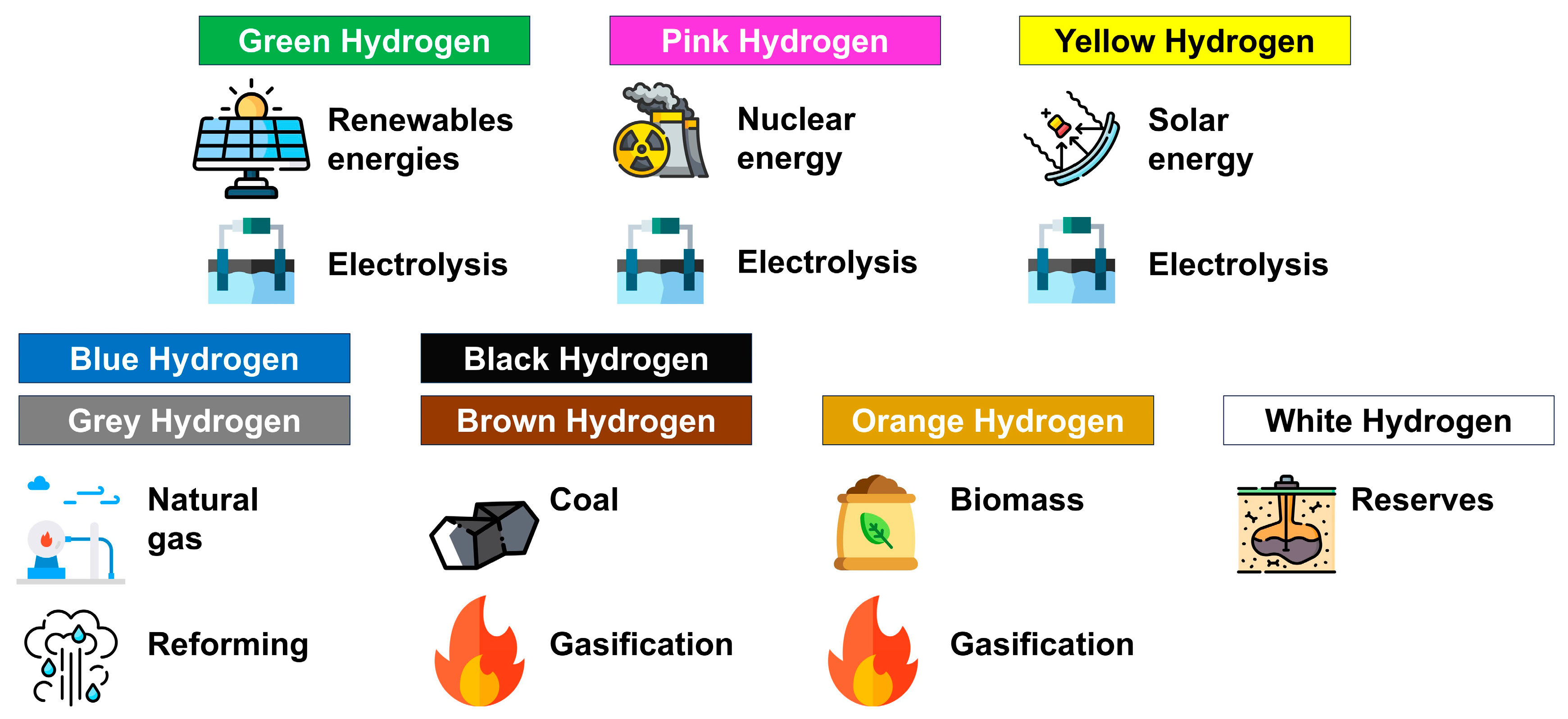
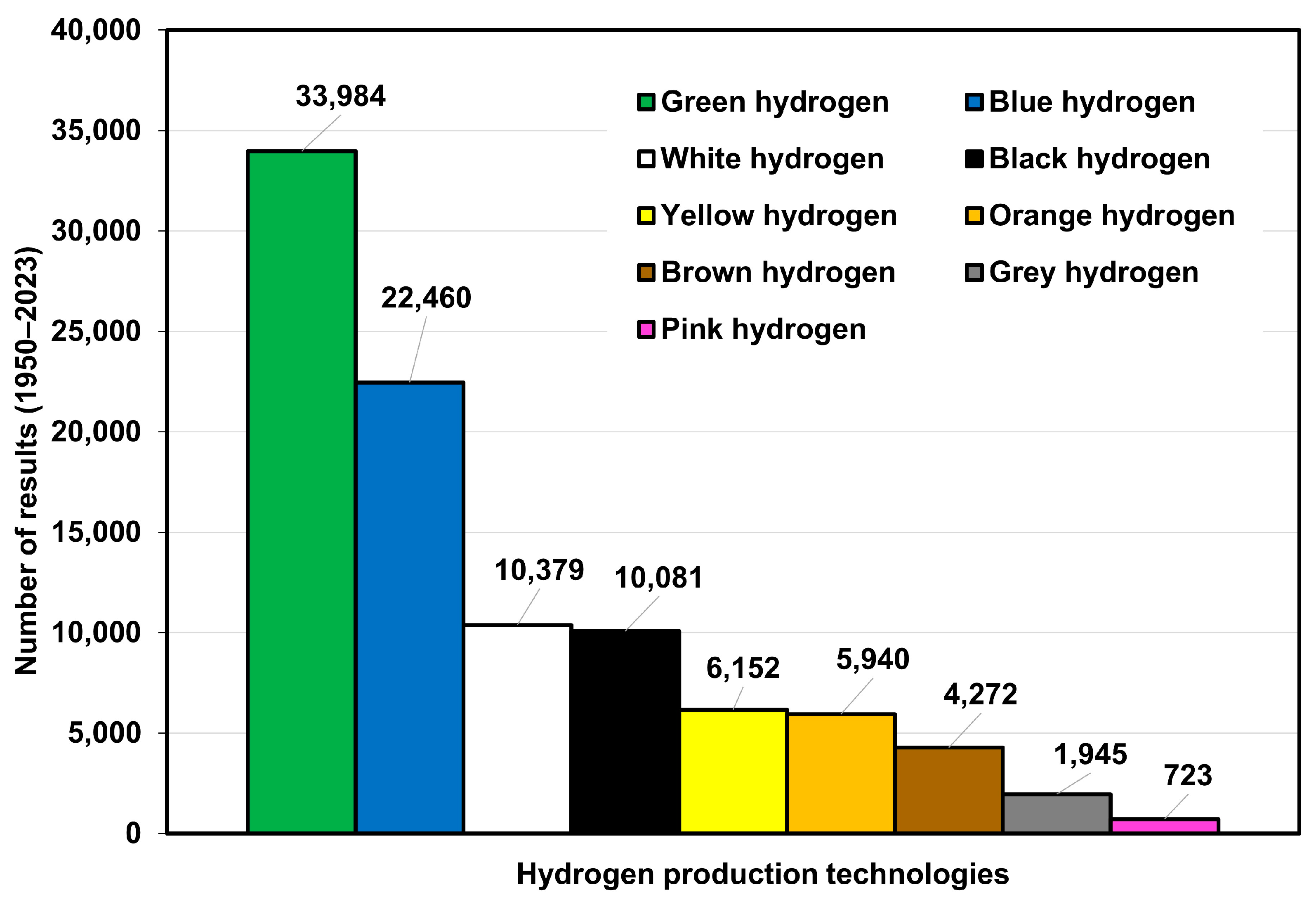


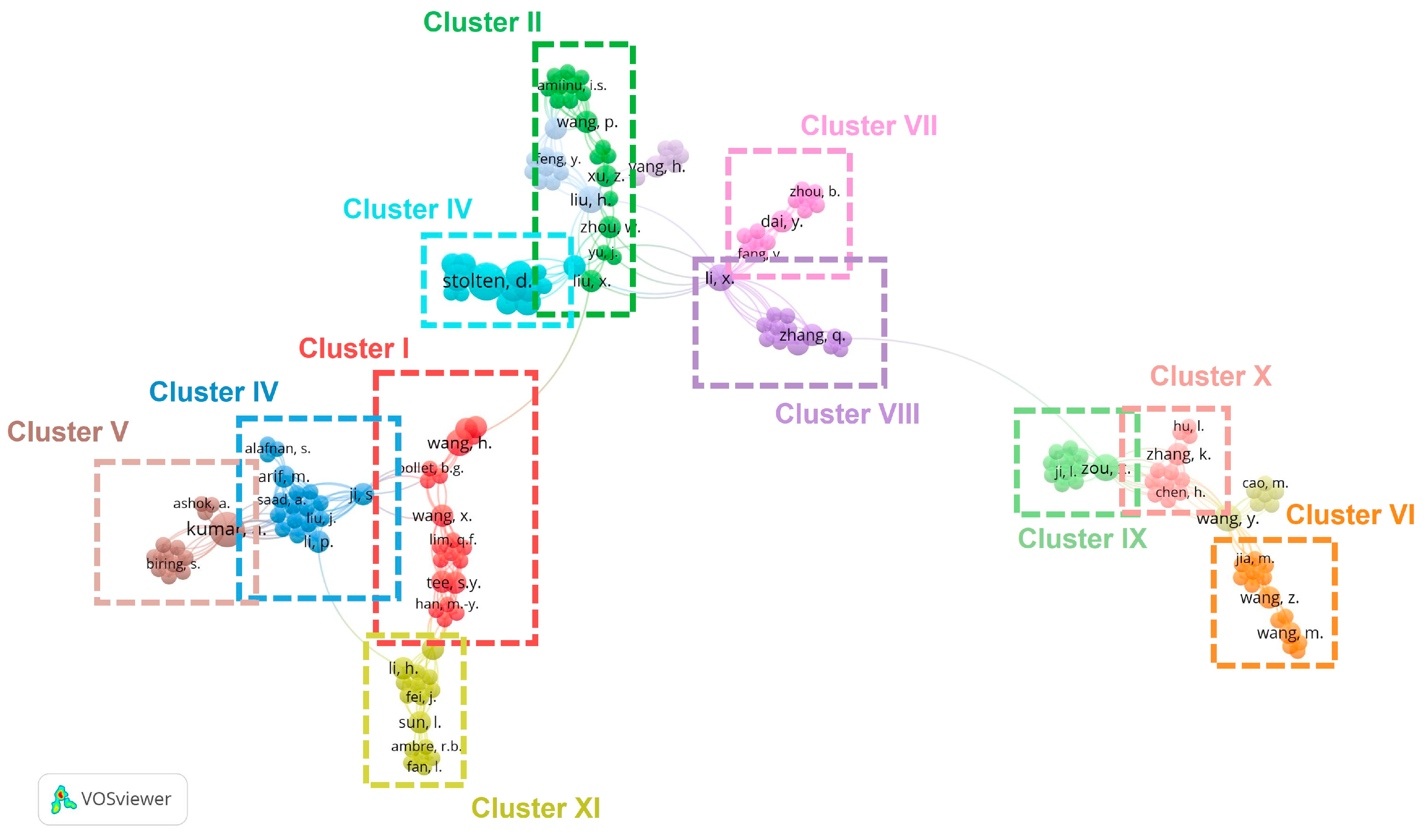
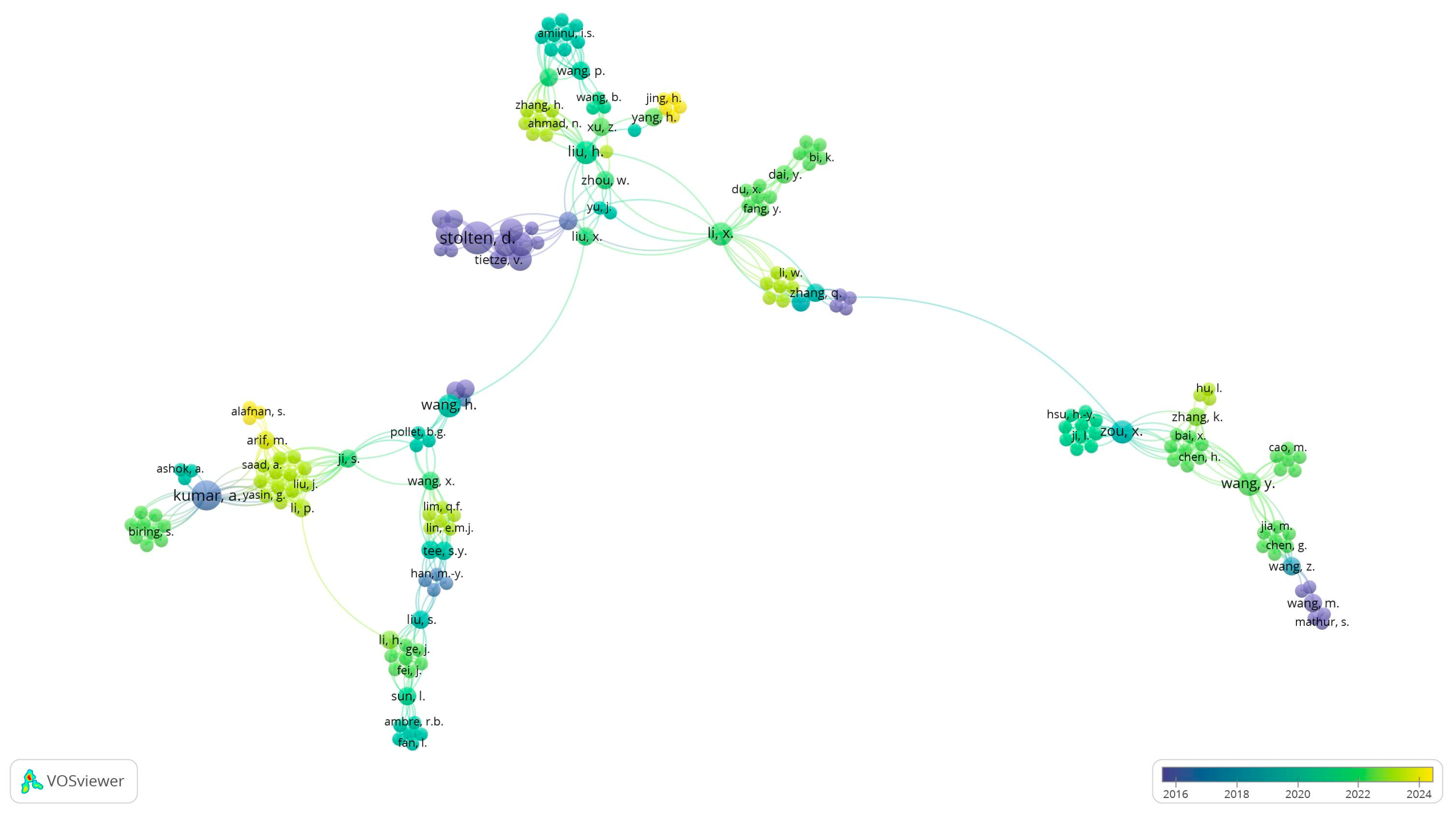
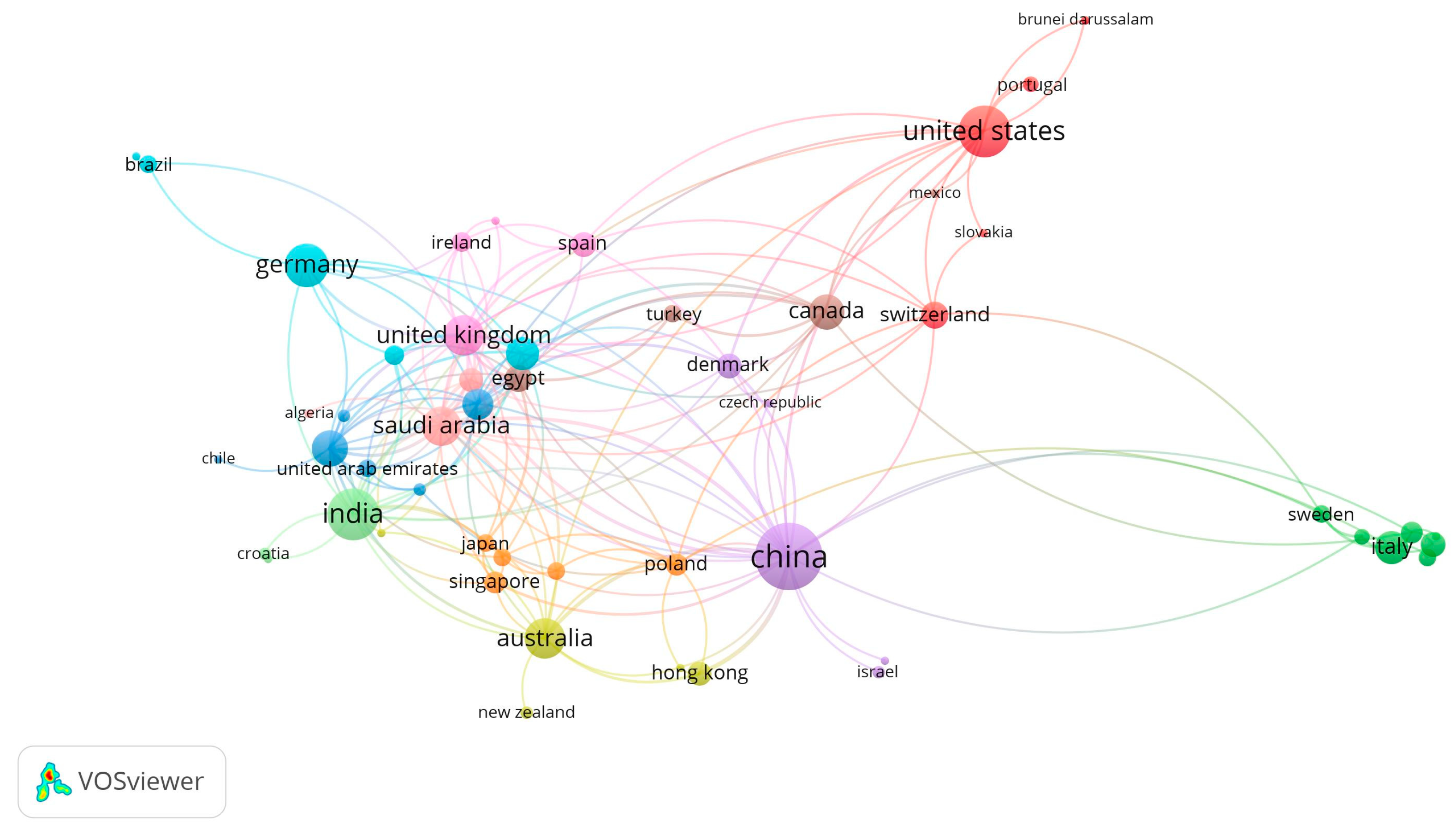


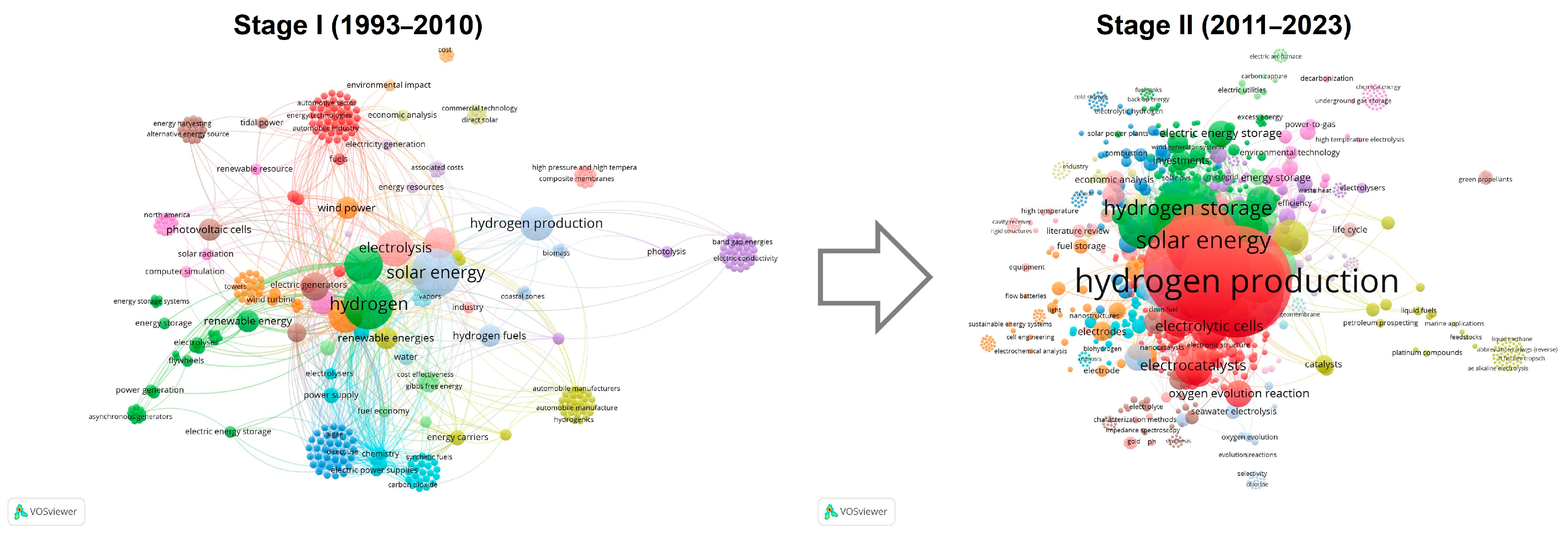

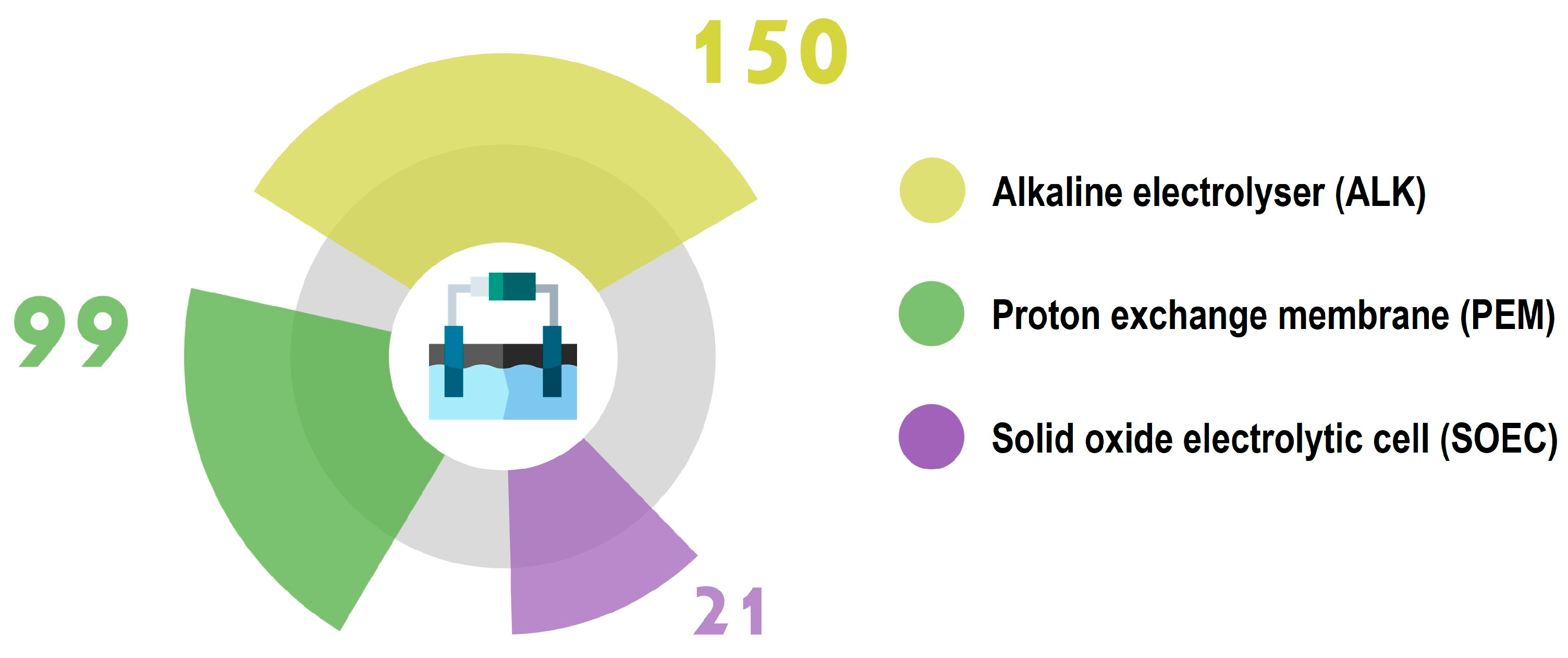
| Search String |
|---|
| TITLE-ABS-KEY ((“hydrogen”) AND (“production” OR “energy” OR “generation”) AND (“generator” OR “electrolysis” OR “electrolyzer” OR “proton exchange membrane” OR “PEM”) AND (“renewable” OR “green”) AND (“solar” OR “photovoltaic”) AND (“state of the art” OR “review” OR “revision” OR “overview”)) |
| Source Type | Number | Percentage |
|---|---|---|
| Journal | 237 | 78.48% |
| Conference Proceeding | 32 | 10.60% |
| Book | 24 | 7.95% |
| Book Series | 9 | 2.98% |
| Ranking | Source Title | Number | Percentage |
|---|---|---|---|
| 1 | International Journal of Hydrogen Energy | 27 | 8.94% |
| 2 | Energies | 19 | 6.29% |
| 3 | Chemical Society Reviews | 12 | 3.97% |
| 4 | High level radioactive waste management (Conference) | 6 | 1.99% |
| 5 | Journal Of Cleaner Production | 5 | 1.66% |
| R | Area | Results | Percentage |
|---|---|---|---|
| 1 | Energy | 169 | 55.96% |
| 2 | Engineering | 109 | 36.09% |
| 3 | Chemistry | 65 | 21.52% |
| 4 | Materials Science | 57 | 18.87% |
| 5 | Chemical Engineering | 54 | 17.88% |
| Keyword | Occurrences | Occurrences (%) | Total Link Strength |
|---|---|---|---|
| hydrogen | 16 | 64.0% | 349 |
| solar energy | 15 | 60.0% | 385 |
| renewable energy resources | 11 | 44.0% | 221 |
| electrolysis | 10 | 40.0% | 194 |
| fuel cells | 9 | 36.0% | 221 |
| hydrogen production | 9 | 36.0% | 176 |
| solar power generation | 8 | 32.0% | 224 |
| hydrogen storage | 7 | 28.0% | 245 |
| electricity | 6 | 24.0% | 226 |
| fossil fuels | 6 | 24.0% | 198 |
| Keyword | Occurrences | Occurrences (%) | Total Link Strength |
|---|---|---|---|
| hydrogen production | 142 | 51.3% | 2405 |
| solar power generation | 132 | 47.7% | 2278 |
| electrolysis | 115 | 41.5% | 2056 |
| solar energy | 80 | 28.9% | 1446 |
| hydrogen | 70 | 25.3% | 1338 |
| hydrogen storage | 61 | 22.0% | 1234 |
| fossil fuels | 60 | 21.7% | 1210 |
| renewable energies | 50 | 18.1% | 895 |
| water electrolysis | 49 | 17.7% | 918 |
| renewable energy | 43 | 15.5% | 718 |
Disclaimer/Publisher’s Note: The statements, opinions and data contained in all publications are solely those of the individual author(s) and contributor(s) and not of MDPI and/or the editor(s). MDPI and/or the editor(s) disclaim responsibility for any injury to people or property resulting from any ideas, methods, instructions or products referred to in the content. |
© 2024 by the authors. Licensee MDPI, Basel, Switzerland. This article is an open access article distributed under the terms and conditions of the Creative Commons Attribution (CC BY) license (https://creativecommons.org/licenses/by/4.0/).
Share and Cite
Fernández-Arias, P.; Antón-Sancho, Á.; Lampropoulos, G.; Vergara, D. On Green Hydrogen Generation Technologies: A Bibliometric Review. Appl. Sci. 2024, 14, 2524. https://doi.org/10.3390/app14062524
Fernández-Arias P, Antón-Sancho Á, Lampropoulos G, Vergara D. On Green Hydrogen Generation Technologies: A Bibliometric Review. Applied Sciences. 2024; 14(6):2524. https://doi.org/10.3390/app14062524
Chicago/Turabian StyleFernández-Arias, Pablo, Álvaro Antón-Sancho, Georgios Lampropoulos, and Diego Vergara. 2024. "On Green Hydrogen Generation Technologies: A Bibliometric Review" Applied Sciences 14, no. 6: 2524. https://doi.org/10.3390/app14062524
APA StyleFernández-Arias, P., Antón-Sancho, Á., Lampropoulos, G., & Vergara, D. (2024). On Green Hydrogen Generation Technologies: A Bibliometric Review. Applied Sciences, 14(6), 2524. https://doi.org/10.3390/app14062524









